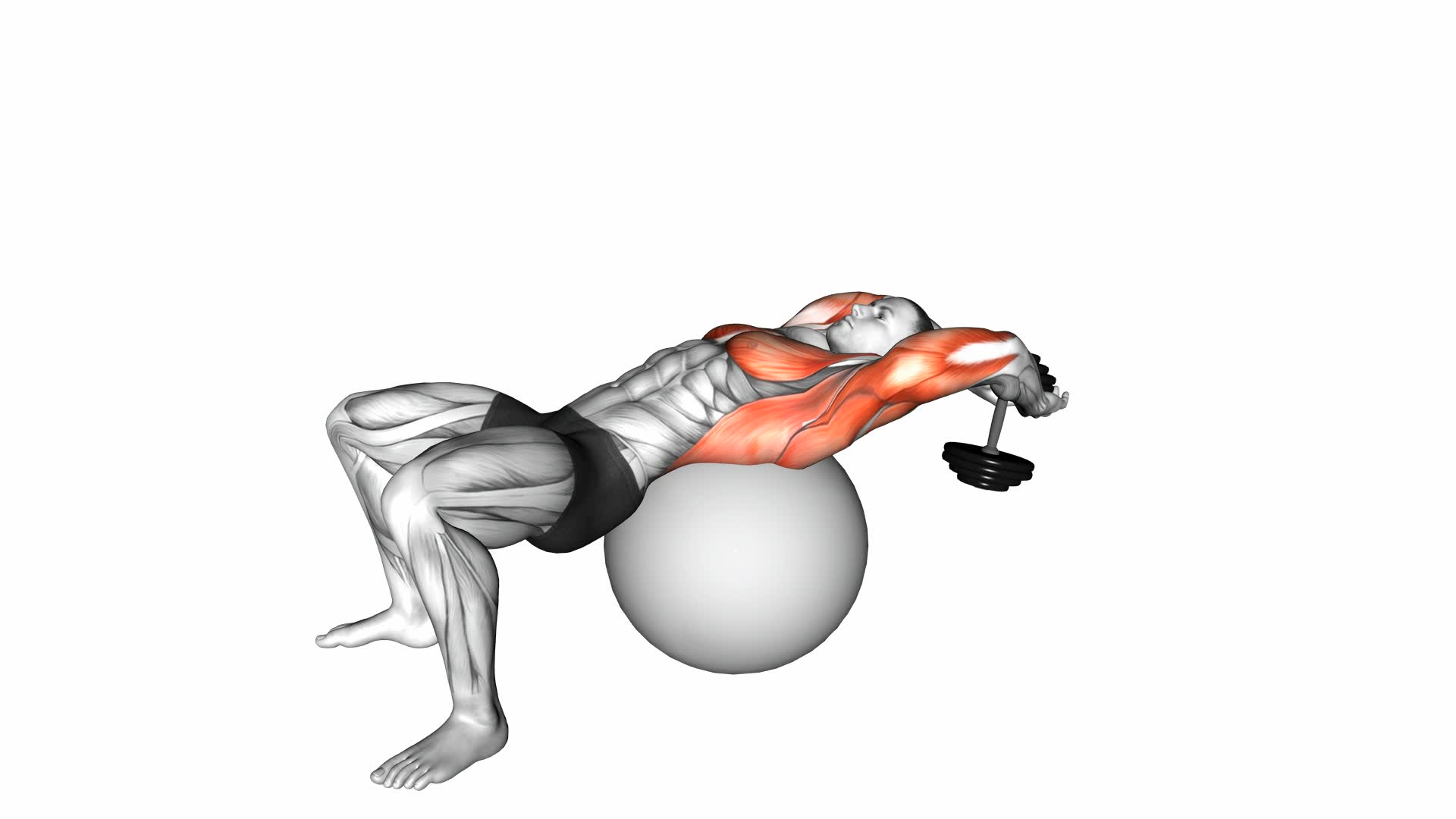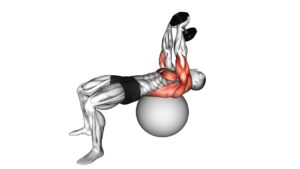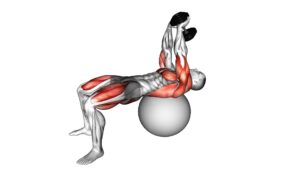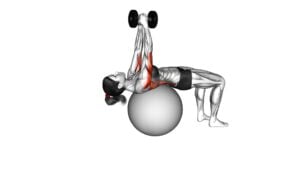Dumbbell Pullover on Exercise Ball – Video Exercise Guide & Tips

Get ready to take your workout to the next level with the dumbbell pullover on an exercise ball.
Watch This Exercise Video
This exercise combines strength training and core stability for maximum results.
In this video exercise guide, you'll learn the proper technique and form, as well as variations and progressions to challenge yourself.
Avoid common mistakes and maximize your results with these expert tips.
Get ready to feel the burn and sculpt your muscles with this challenging exercise.
Key Takeaways
- Dumbbell Pullover on Exercise Ball targets multiple muscle groups, including chest, back, and triceps
- It improves stability, coordination, and balance
- Using an exercise ball adds instability and engages core muscles
- Proper form and technique are crucial to minimize the risk of injury and maximize results
Benefits of Dumbbell Pullover on Exercise Ball
You can experience enhanced stability and core strength by incorporating the dumbbell pullover on an exercise ball. The dumbbell pullover is a versatile exercise that targets multiple muscle groups, including the chest, back, and triceps. When performed on an exercise ball, this exercise becomes even more challenging and beneficial.
One of the main benefits of performing the dumbbell pullover on an exercise ball is improved stability. The unstable surface of the exercise ball forces your core muscles to engage in order to maintain balance throughout the movement. This not only strengthens your core, but also helps improve your overall stability and coordination.
Additionally, the exercise ball provides an increased range of motion compared to performing the dumbbell pullover on a flat surface. This allows for a greater stretch and contraction of the targeted muscles, resulting in improved muscle activation and development.
Furthermore, incorporating the dumbbell pullover on an exercise ball can help improve your posture. This exercise targets the muscles in your upper back and shoulders, which are often neglected in traditional chest exercises. By strengthening these muscles, you can improve your posture and reduce the risk of developing rounded shoulders.
Equipment Needed for Dumbbell Pullover on Exercise Ball
To perform the dumbbell pullover on an exercise ball, you'll need two essential pieces of equipment: dumbbells and an exercise ball.
Dumbbells are necessary for providing resistance and targeting the muscles in your upper body, while the exercise ball adds an element of instability, engaging your core muscles.
Essential Equipment for Pullover
To perform the dumbbell pullover on an exercise ball, you'll need the following essential equipment: an exercise ball, a set of dumbbells, and a mat for added stability.
The exercise ball provides an unstable surface, challenging your core muscles and improving balance during the exercise.
The dumbbells allow you to add resistance and target your upper body muscles effectively. Make sure to choose a weight that challenges you but still allows you to maintain proper technique throughout the exercise.
The mat is optional but can provide extra cushioning and support for your back during the movement.
With the right equipment, you can safely and effectively perform the dumbbell pullover on an exercise ball, reaping the benefits of this challenging exercise.
Benefits of Exercise Ball
When performing the dumbbell pullover on an exercise ball, the exercise ball provides an unstable surface, challenging your core muscles and improving balance during the exercise. The exercise ball offers several benefits for stability training and exercises for core strength and stability.
Here are three key benefits of using an exercise ball for the dumbbell pullover:
- Increased core activation: The unstable surface of the exercise ball forces your core muscles to engage and stabilize your body throughout the exercise. This helps to strengthen and tone your abdominal muscles, lower back, and obliques.
- Improved balance and coordination: Balancing on the exercise ball requires constant adjustments and control, which enhances your overall balance and coordination. This can have a positive impact on your performance in other sports or activities that require stability.
- Enhanced proprioception: Proprioception refers to your body's ability to sense its position in space. By performing the dumbbell pullover on an exercise ball, you challenge your proprioceptive abilities, which can improve your overall body awareness and control.
Proper Form and Technique for Dumbbell Pullover on Exercise Ball
To perform the dumbbell pullover on an exercise ball with proper form and technique, you should position yourself on the ball with a dumbbell in hand. This exercise is a great way to engage your chest, back, and core muscles while also challenging your stability.
However, it's important to avoid common mistakes and maintain proper form throughout the movement. One common mistake is using a weight that's too heavy, which can lead to improper form and potential injury. Start with a lighter weight and gradually increase as you become more comfortable and confident with the movement.
Another mistake to avoid is arching your back excessively or allowing your hips to drop. Keep your core engaged and maintain a neutral spine throughout the exercise.
In addition to these common mistakes, it's important to understand the benefits of using an exercise ball for this exercise. The instability of the ball forces your muscles to work harder to maintain balance, which can lead to increased muscle activation and a more effective workout. Additionally, using an exercise ball can help improve your overall balance and coordination.
Now that you understand the proper form and technique, let's explore variations and progressions for the dumbbell pullover on an exercise ball.
Variations and Progressions for Dumbbell Pullover on Exercise Ball
Try incorporating different dumbbell weights to increase the challenge and intensity of your dumbbell pullover on the exercise ball. Here are some variations and progressions you can try to take your workout to the next level:
- Single-arm dumbbell pullover: Instead of using both arms, perform the exercise with one arm at a time. This will engage your core muscles more and challenge your stability.
- Decline dumbbell pullover: Positioning the exercise ball on a decline bench will increase the difficulty of the exercise and target your upper chest and shoulders more effectively.
- Superset with other exercises: Combine the dumbbell pullover with other upper body exercises like push-ups or dumbbell rows to create a challenging superset workout.
By incorporating these variations and progressions, you can keep your workouts interesting while continuously challenging your muscles. Remember to start with lighter weights and gradually increase the resistance as you become more comfortable with the exercises.
It's important to maintain proper form and technique throughout to avoid any injuries.
Common Mistakes to Avoid During Dumbbell Pullover on Exercise Ball
To ensure a safe and effective dumbbell pullover on the exercise ball, there are some common mistakes that you should avoid. By being aware of these mistakes and implementing the correct technique, you can maximize the benefits of this exercise while minimizing the risk of injury.
One common mistake to avoid is using too much weight. It's important to start with a weight that you can comfortably manage and gradually increase it as you become stronger. Using weights that are too heavy can lead to improper form and strain on your muscles and joints.
Another mistake isn't maintaining proper alignment. When performing the dumbbell pullover on the exercise ball, make sure your head, neck, and spine are all in a neutral position. Avoid arching your back or allowing your shoulders to round forward. This will help to protect your spine and ensure that you're targeting the correct muscles.
Additionally, avoid rushing through the exercise. The dumbbell pullover on the exercise ball requires controlled movements and proper breathing techniques. Take your time and focus on engaging your core and chest muscles throughout the entire range of motion.
Lastly, it's important to avoid using momentum to complete the exercise. Instead, concentrate on using your muscles to move the weight. This will help to maximize the effectiveness of the exercise and prevent unnecessary strain on your joints.
Tips for Maximizing Results With Dumbbell Pullover on Exercise Ball
To maximize your results with the dumbbell pullover on an exercise ball, it's crucial to focus on proper form techniques and weight selection.
Ensure that you maintain a stable position on the exercise ball and engage your core muscles throughout the exercise.
Additionally, choose a weight that challenges you without compromising your form.
Proper Form Techniques
For maximum results with the dumbbell pullover on an exercise ball, focus on maintaining proper form throughout the exercise. Here are some tips to help you achieve optimal form:
- Keep your core engaged and your back flat against the exercise ball.
- Maintain a slight bend in your elbows throughout the movement.
- Control the movement and avoid using momentum to lift the dumbbell.
By following these form techniques, you'll be able to effectively target your chest, back, and shoulder muscles while minimizing the risk of injury.
It's also important to be aware of common mistakes, such as arching your back or allowing your shoulders to shrug up. Additionally, you can progress the exercise by increasing the weight of the dumbbell or adding a stability challenge by using a Swiss ball instead of an exercise ball.
Weight Selection Tips
To maximize your results with the dumbbell pullover on an exercise ball, it's important to properly select the appropriate weight. The weight selection plays a crucial role in muscle activation and overall effectiveness of the exercise.
Choosing a weight that's too light may not provide enough resistance to challenge your muscles and stimulate growth. On the other hand, selecting a weight that's too heavy can lead to poor form and increased risk of injury. It's recommended to start with a lighter weight and gradually increase as you become more comfortable and confident with the exercise.
Listen to your body and choose a weight that allows you to perform the exercise with proper form and a full range of motion. Remember, quality of movement is key for maximizing your results.
Frequently Asked Questions
How Many Repetitions and Sets Should I Do for the Dumbbell Pullover on an Exercise Ball?
For the dumbbell pullover on an exercise ball, the number of repetitions and sets can vary depending on your fitness level and goals. It's generally recommended to start with 2-3 sets of 8-12 repetitions.
This exercise targets your back, chest, and core muscles, improving strength and stability. Incorporating the exercise ball adds an extra challenge, engaging your stabilizing muscles.
Remember to use proper form and gradually increase the weight as you progress.
Can I Perform the Dumbbell Pullover on an Exercise Ball if I Have Lower Back Pain?
If you have lower back pain, it may not be advisable to perform the dumbbell pullover on an exercise ball. This exercise can put strain on your lower back, exacerbating your pain.
However, there are alternative exercises that can provide similar benefits without the risk of aggravating your condition. Using an exercise ball can help improve balance and core stability, so consider other exercises that target those areas, such as planks or bird dogs.
Is the Dumbbell Pullover on an Exercise Ball Suitable for Beginners?
Yes, the dumbbell pullover on an exercise ball can be suitable for beginners. It's a challenging exercise that targets multiple muscle groups, but it can be modified to accommodate your fitness level. If you're a beginner, it's important to start with lighter weights and focus on proper form.
Additionally, there are alternative exercises for beginners on an exercise ball that can help build strength and stability. Avoid common mistakes such as arching your lower back or using momentum to lift the weight.
Can I Substitute the Dumbbell With a Kettlebell or Resistance Band for This Exercise?
Yes, you can substitute the dumbbell with a kettlebell or resistance band for this exercise. Both options offer an effective alternative to the dumbbell pullover on an exercise ball.
The kettlebell provides a different grip and weight distribution, while the resistance band adds variable resistance.
Experiment with both options to find which one works best for you and gives you the desired results. Remember to maintain proper form and consult a fitness professional if needed.
Are There Any Precautions or Contraindications I Should Be Aware of Before Attempting the Dumbbell Pullover on an Exercise Ball?
Before attempting the dumbbell pullover on an exercise ball, there are a few precautions and contraindications to be aware of.
It's important to check with your doctor or a certified trainer if you have any pre-existing medical conditions or injuries that may be aggravated by this exercise.
Additionally, make sure the exercise ball is stable and properly inflated to avoid any accidents or falls.
Always start with a lighter weight and gradually increase as you feel comfortable and confident.
Conclusion
In conclusion, the dumbbell pullover on an exercise ball is an effective exercise for targeting the chest, back, and core muscles.
It offers benefits such as improved upper body strength, increased flexibility, and enhanced stability.
By following proper form and technique, avoiding common mistakes, and incorporating variations and progressions, you can maximize your results with this exercise.
Incorporating the dumbbell pullover on an exercise ball into your workout routine can help you achieve your fitness goals.

Author
Years ago, the spark of my life’s passion ignited in my mind the moment I stepped into the local gym for the first time. The inaugural bead of perspiration, the initial endeavor, the very first surge of endorphins, and a sense of pride that washed over me post-workout marked the beginning of my deep-seated interest in strength sports, fitness, and sports nutrition. This very curiosity blossomed rapidly into a profound fascination, propelling me to earn a Master’s degree in Physical Education from the Academy of Physical Education in Krakow, followed by a Sports Manager diploma from the Jagiellonian University. My journey of growth led me to gain more specialized qualifications, such as being a certified personal trainer with a focus on sports dietetics, a lifeguard, and an instructor for wellness and corrective gymnastics. Theoretical knowledge paired seamlessly with practical experience, reinforcing my belief that the transformation of individuals under my guidance was also a reflection of my personal growth. This belief holds true even today. Each day, I strive to push the boundaries and explore new realms. These realms gently elevate me to greater heights. The unique combination of passion for my field and the continuous quest for growth fuels my drive to break new ground.







